Duck Troubles
The long wait begins
At last, the time had come. One we noticed from the cameras that Jemima had not left the nest and was still on it, incubation had begun! We made a note on our calendar and started counting down to hatching day - 28 days on.
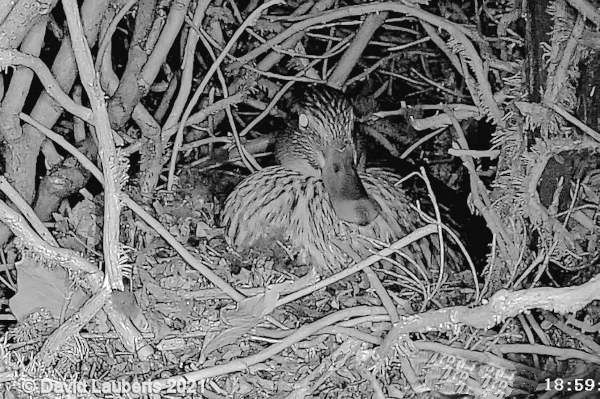
Jemima's first night on her eggs
Generally, Jemima would stay on her eggs overnight and in the morning, the time varied, she would cover her eggs with leaves and down, and disappear, usually for an hour or so, before returning. Sometimes she would return alone, sometimes she returned with her mate.
They would land on the pond, and shortly afterwards, Jemima would hop up onto the pond wall, look around and then fly up to the top of the hedge before burrowing carefully down to the top of the wall and into her nest. The drake, if he was there, would fly off once Jemima flew to the top of the hedge.
We assume that Jemima was going to visit her normal waterside haunt to feed and bath, she seemed quite happy for her drake to come back with her as she returned to her nest.
Each evening, again at various times, she would once again fly off for an hour or so, once again returning to the nest, sometimes alone, sometimes with her drake, who flew away again once she was went to the top of the hedge.
As time went on, her nest seemed to grow deeper and deeper as she pulled down from her chest and laid it round herself and the eggs.
We started making plans for what to when they arrived. Deciding not to repeat last year by trying to catch them under the net, we had read that you could try leaving a cat basket around with its door open and some duck food around. The idea was Jemima would get used to it, eat the food and even go into it by herself on her own accord. We tried this, but it may as well not have existed as far as Jemima was concerned, she totally ignored it and the food in and around it. Next idea please!
We then thought that we would construct a coop from wood and chicken wire, about 1.5m long x 0.7m high and 1 m wide. At the minimum it would be a place to coral them into to catch them, and it may also a place for them to stay at night if we thought she was going to stay and raise her family in the garden. It was designed so that we could take it apart and store it 'flat pack' style around the back of the sheds.
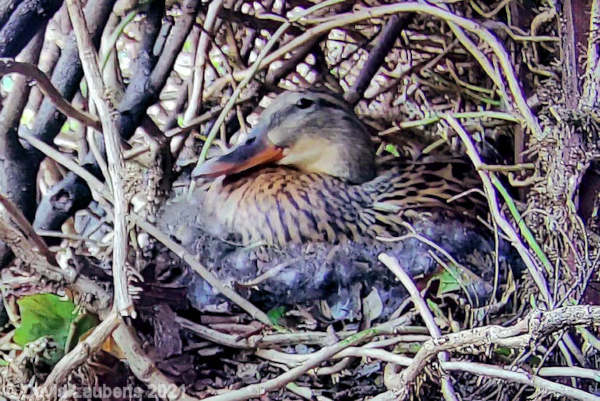
Down in nest increasing
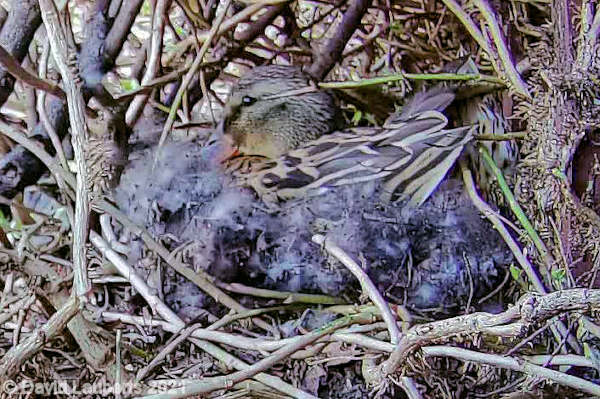
Down in nest increasing
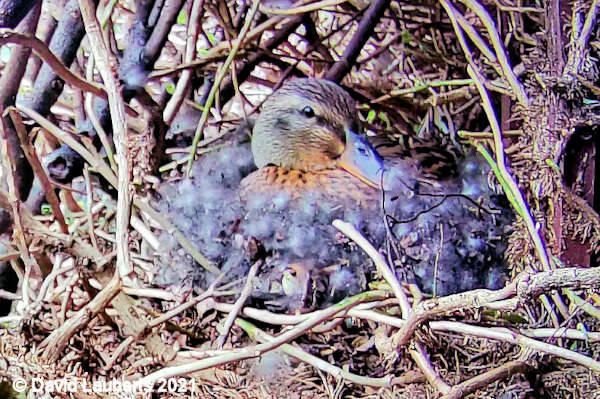
Down in nest increasing
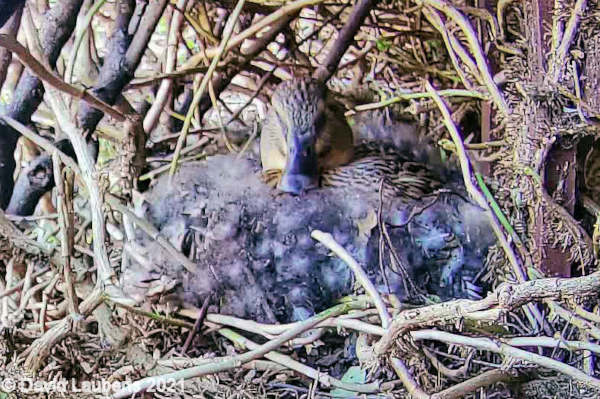
Down in nest increasing
Troubles
However, all was not always well for Jemima in this little journey.
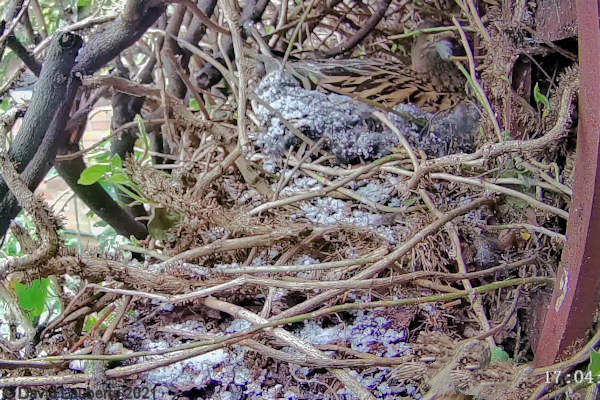
In the snow
Both weather and visitors came to trouble her, some more of an issue than others.
We are in England and the weather is always changeable. No more so then in April. We had a little snowstorm, but Jemima did not seem to mind, she snuggled down on her nest during the little flurry that got through the hedge onto her nest. Soon after it finished off, she went for her afternoon 'my time' moment, leaving the down covered eggs under a layer of snow.
One day, when she returned with a drake and started to act very strangely. Landing in the pond with the drake, she did not seem at ease. She was holding herself in a different way and was not interested in jumping on the wall to return to her nest.
After a while, out she got and wandered across the garden to the other pond making a particular quacking sound on her way. Dutifully the drake followed. Jemima kept coming back towards the nest but was obviously not wanting the drake to follow. The moment she saw him following, she'd turn back to the furthest pond, quacking at him in a peculiar way.
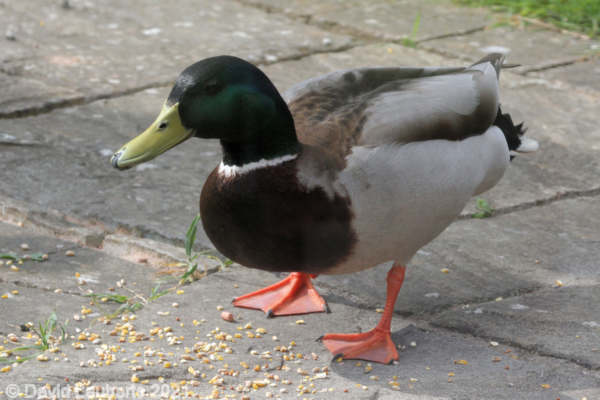
The unwanted suiter
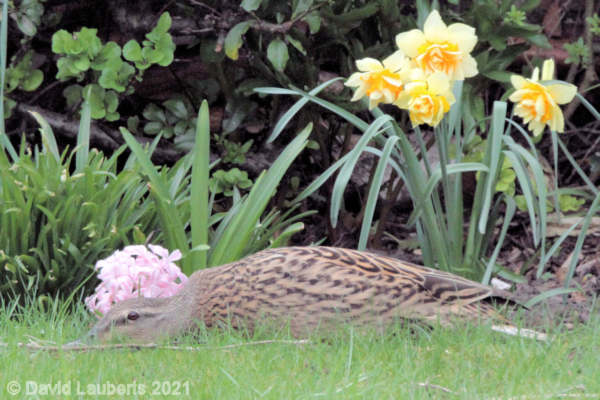
Jemima hiding from her foe
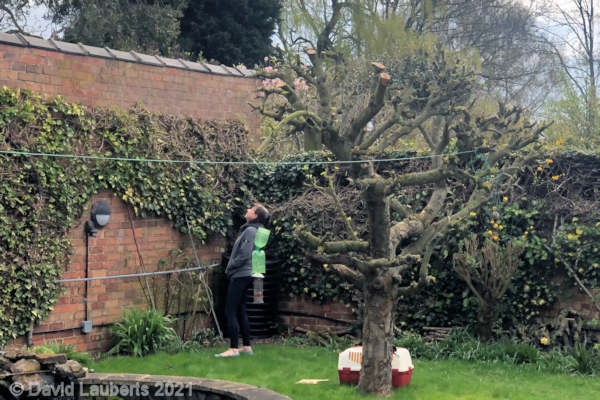
Trying to see off the drake
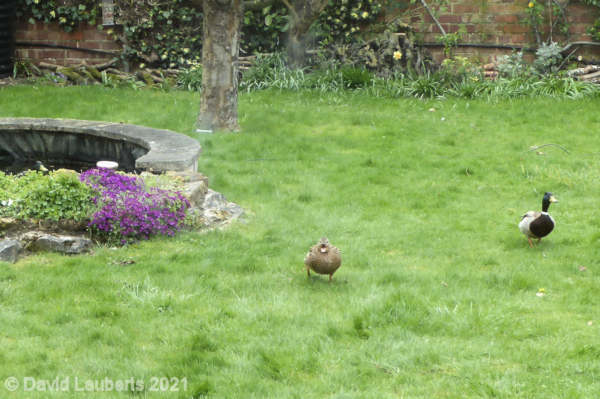
Jemima running from two drakes
One time she even went behind our sheds, along a complicated route involving going through a hole in a wall, to follow the wall to her nest. The drake was quickly waddling round the garden trying to find her. Jemima, sunk to the ground, head extended and flat to the ground trying to hide. The drake saw her and back she went quacking towards the pond, away from her nest. We managed to catch some of this on the hedgehog cams in the clip below.
Even when we went outside to try and see if he would fly away, he was not for going! Eventually she managed to get back to her nest, but the drake was flying around the hedge, again he did not seem to be afraid of us when we approached him.
Jemima was pursed at least four times, the last time she was off the nest for several hours and had to return late at night. She even tried, unsuccessfully, her 'lying low' tactic while she was in the pond to try and hide from the amorous drake. At this point we had no idea on how viable her eggs were as she had had several sustained periods of being away from her nest. Time would tell but we thought there would be several failures because they had got too cold when she was off the nest.
From reading things on-line (you can read so much but all of it is not quite right!) in case the first clutch fails she will renest and lay a second clutch. Therefore their partner drake stays with her until the clutch hatches. The drakes at this time are still sexually active, until they start moulting, and will pursue female mallards at this time. I am not sure if the female avoids going back to her nest in these instances in case the unwanted attentions damage the eggs.
In between times she would also return with, we assume, her partner drake. She was totally different in terms of behaviour with this drake. They would, as normal, land in the pond, she would almost immediately fly to go back to her nest and the drake would fly away. Once she returned with two drakes, one appeared to be her 'partner', they all flew off elsewhere to resolve their squabbles before she returned alone.
Jemima and her nest also had animal and bird visitors, some seemingly friendly, some not so. These include blackbirds, robins and dunnocks looking in the nest to mice and cats.
Some clips of the activities can be seen below.
Jemima's nest was quite well hidden from all, the birds wandered in because that's what they do in hedgerows, the mouse because it uses the wall as a run through, safe from the local cats. They were regular 'wall runners' till Jemima put here nest there, and they stopped using it till she left.
The cat visitor was unusual, one night it had decided to walk across the top of the hedge, above where Jemima was nesting. This movement appears to have disturbed her and she shot sideways through the hedge and away into the night. The cat, hearing her go came down through the hedge, and down onto the nest, and then out sideways.
Jemima was away for over 9 and 1/2 hours that time, during what was to be the coldest recorded night in the UK, returning early in the morning with her drake. The cat however was young, apparently curious, and returned the next morning to see what was in the nest. Our hedgehog cams caught him sneaking in and along the wall towards Jemima's nest. The cat climbs the laurel bush back into the nest with Jemima in it. Jemima sees the cat come in and escapes sideways. The cat, I think thinking some small bird would be there, seemed terrified and shot out the hedge, and out the garden! Jemima returned safely to her nest and job, though we again thought her spell away had done her eggs no good at all.